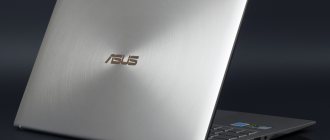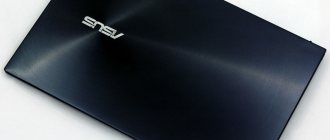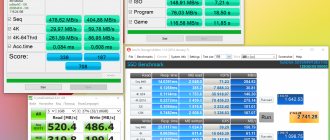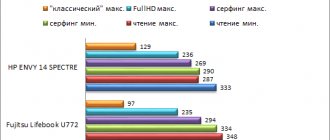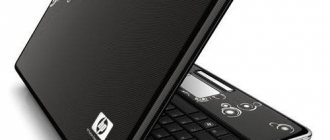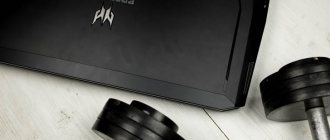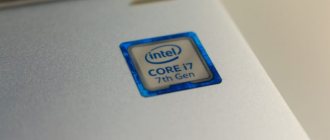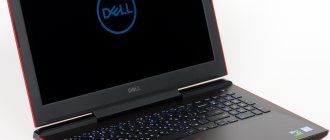The first Zenbook was presented almost ten years ago, during the era of ultrabook development, when manufacturers desperately competed for every millimeter of case thickness and battery life. At that time, the first Zenbook models were compared to the Apple MacBook Air, which was similar in appearance and concept. Today the Zenbook line is presented in various modifications and variations, up to the second screen. But many things have remained unchanged: a metal case, high battery life, fast processors and storage. Yesterday, June 22, ASUS presented new models: UX325 and UX425, let's get acquainted with the second.
Technologies ASUS ZenBook 14 UX425
Dimensions and weight
With fairly high-performance components, the laptop remains thin and very light. Its thickness is only 14 mm and its weight is only 1.13 kg. Those. you can carry it with you all day without being cumbersome. All this is possible thanks to the use of new technologies and developments.
Long battery life
Even with a Core i7 processor, ASUS claims battery life of up to 22 hours. This is probably not in the most intense mode, but even under high load, the laptop will definitely last more than 12-14 hours. And if you do need to charge quickly, the battery will reach 60% charge in just 49 minutes. Those. One hour of charging, and again you can work all day away from outlets.
Camera with face recognition
Tired of entering your password every time you return to your laptop? Forget about it, the built-in IR camera has facial recognition, meaning you just look at the screen and Windows Hello will unlock the system when it recognizes you as the owner of the device. Modern technology is so convenient!
⇡#Appearance and input devices
ZenBook Pro Duo has a recognizable design. Those who created this device decided to use strict, chopped forms - in my opinion, it turned out quite nice. The laptop body is made entirely of aluminum, the color is called Celestial Blue. However, we were, of course, primarily attracted to the additional screen of the ScreenPad Plus. More precisely, a combination of displays.
The main screen with a diagonal of 15.6 inches has a resolution of 3840 × 2160 pixels and a standard aspect ratio of 16:9. The ZenBook Pro Duo uses an OLED panel, but we will talk about its quality characteristics in the second part of the article. The touch screen has a glossy surface. The thickness of the frames on the left and right is 5 mm, and on the top - 8 mm. ASUS has already accustomed us to thin frames - you quickly get used to good things.
The additional screen with a diagonal of 14 inches has a resolution of 3840 × 1100 pixels, that is, the aspect ratio is 14:4. It is also touch sensitive, but has a matte finish.
By default, both screens work in expansion mode. At the same time, ScreenPad Plus has its own menu, very reminiscent of the Start menu of the Windows operating system. Here we can change the settings of the additional screen, as well as launch applications that are downloaded in the My ASUS program. For example, the Quick Key program is preinstalled - it provides access to frequently used key combinations. Of course, you can customize your own combinations.
The ScreenPad Plus menu allows you to manipulate displays in different ways. So, there is a Task Swap function - when you press a key, windows open on different screens swap places. There is a ViewMax option - when you turn it on, for example, the browser is stretched across both panels. There is a Task Group mini-program: click on the icon and the laptop launches several applications at once. The Organizer menu allows you to symmetrically arrange windows on the secondary display. Finally, the App Navigator option shows in the form of a feed all the programs running on the laptop.
Who needs a laptop with two such screens? In my opinion, ZenBook Pro Duo can be a great assistant for those who work with video and photo editing. Everything is quite simple here: ScreenPad Plus will allow you to place the most frequently used submenus of graphic editors on the second display. Thus, we will not overload the main screen.
ZenBook Pro Duo is also useful for programmers, because the code window can be stretched across both displays. Finally, the additional screen will be convenient for streamers - chat and, for example, the OBS menu can be placed here.
I've been using the ZenBook Pro Duo for just over a week. Due to my line of work, I have to constantly hang out on social networks and instant messengers. Therefore, it turns out to be quite convenient, for example, to write an article - and at the same time communicate on Telegram or Facebook. And now I’m writing this text, and the ScreenPad Plus displays a review of the ASUS ROG Strix SCAR III laptop (G531GW-AZ124T) - this makes it more convenient to view graphs with test results.
The only point: you need to get used to the location of the second screen. Because you have to tilt your head down a lot - and still you look at the ScreenPad Plus at a far from right angle.
As we have already found out, the laptop has very powerful hardware. Obviously, in comparison with other Zenbooks, the Pro Duo version is by no means an ultrabook. Thus, the thickness of the device is 24 mm, and its weight is 2.5 kg. Add an external power supply here - and now you have to carry 3+ kg of additional luggage with you. In this regard, ZenBook Pro Duo is not much different from 15-inch gaming laptops.
The lid of the hero of today's testing opens approximately 140 degrees. The hinges on the ZenBook Pro Duo are tight and position the screen well. The lid can be easily opened with one hand.
Holding the laptop on your lap is not very comfortable, since the hinges noticeably lift the laptop body and dig into the body. The engineers were forced to use Ergolift hinges in the ZenBook Pro Duo by two things: firstly, they needed to provide the laptop cooler with good air flow, and secondly, they tried to make it more convenient to use the ScreenPad Plus (look at it from a smaller angle).
The Zenbook doesn't have very many connectors. On the left side there is an HDMI output and USB 3.1 Gen2 A-type. On the right is Thunderbolt 3 combined with USB C-type, another USB 3.1 Gen2 A-type and a 3.5 mm headset jack. Eh, a laptop designed for photo and video editors clearly lacks a card reader! Most of the left and right sides are occupied by the perforated grille of the laptop cooling system.
The ZenBook Pro Duo has a backlight on the front panel.
The keyboard of the ZenBook Pro Duo is compact. I’ll warn you right away: the vertically positioned touchpad and tiny F1-F12 keys will take some getting used to. At the same time, the touchpad is also equipped with a digital keypad. A number of F1-F12 buttons, as in ultrabooks, by default work in combination with the Fn button, while priority is given to their multimedia functions. The keyboard has a three-level white backlight. In the daytime, the signs on the buttons with the backlight on are clearly visible, and even more so in the evening and at night.
In general, after getting used to it, working with the Zenbook keyboard is quite convenient. The key travel is 1.4 mm. The only thing you have to do is place the laptop itself further away - 10-15 centimeters from you.
The webcam in the ZenBook Pro Duo is standard - it allows you to shoot with a resolution of 720p at a vertical scan frequency of 30 Hz. I note that the laptop supports Windows Hello facial recognition.
Internal structure and upgrade options
The laptop is quite easy to disassemble. To get to the components, you need to unscrew several screws - two of them are hidden by rubber plugs. The screws are Torx, so you will need a special screwdriver.
The cooling system of the ZenBook Pro Duo looks quite interesting. First, we note the presence of five heat pipes. Four of them are responsible for removing heat from the CPU and GPU. Secondly, the fans are quite far apart from each other. It can be seen that the impellers blow air outside the housing on the sides. The manufacturer claims that each fan is equipped with a 12-volt motor and 71 blades.
What can we replace in ZenBook Pro Duo? In our case, there seems to be no point in going under the cover at all. Perhaps one terabyte SSD will not be enough for someone - then yes, over time the Samsung MZVLB1T0HALR drive may give way to a two-terabyte solid-state drive. But 32 GB of RAM should be enough for a long time.
True, one point must be taken into account. The manufacturer's official website states that versions of the laptop with 8, 16 and 32 GB of RAM will be available for sale. In the photo above we see that the RAM of the Zenbook is soldered, its volume cannot be increased over time. Please consider this point before purchasing.
Laptop ASUS ZenBook 14 UX425
As you can guess from the names of the new products (UX325 and UX425), they differ in screen diagonal, and since we have the UX425 model, we have a laptop with a 14-inch screen diagonal. In fact, I have to say that this is my favorite screen size for compact laptops. Because personally, 13 inches seem small to me, and 15 inches can no longer be so compact. Therefore, for me, a screen diagonal of 14 inches is the golden mean, when the compact dimensions are preserved, the hardware is decent, and the screen is relatively large. Since I started talking about the screen, let’s continue about it. No TN or bad viewing angles. Zenbook series laptops are equipped only with top-end displays with perfect color reproduction and good viewing angles. This makes working on a laptop very comfortable and productive. Whether you want to edit photos or videos, you can be confident that the display will reproduce the colors correctly. The screen brightness is 400 cd, and the relative area is 90%. This is possible thanks to NanoEdge frames, which are 3-4 mm thick. This creates the effect of a frameless display. The only thing that the screens of all laptops in the Zenbook line lack is an increased refresh rate of up to 120-165 Hz, but this is the lot of gaming models.
The case is incredibly thin, just 13.9mm at its thickest point, meaning the entire laptop is only slightly thicker than an iPhone 11 Pro Max with a case.
But only here is a whole laptop with a huge screen. The weight of the laptop is only 1.13 kg, which is also incredibly low and cool. Yes, this is not a gaming laptop, but the only thing that makes it not a gaming laptop is the lack of a high-performance video card; all other components are up to par and provide very high performance.
The body, as I said above, is made of metal. This makes it durable, cool and pleasant to the touch. On the left side there is a full-size HDMI and two USB Type-C with charging capabilities, combined with Thunderbolt 3. On the other side you will find a classic USB and a MicroSD card slot, and that's where the ports end. in fact, I can’t say that there’s anything missing here. Maybe I would change HDMI to DisplayPort, but that's it. The lack of a 3.5 audio jack seems very unusual, but the kit includes an adapter.
The keyboard is completely classic for the ZenBook line, large island-type buttons, key travel 1.4 mm, comfortable to type, white backlight. On the right side there are additional buttons, such as Home, PgUp, etc. But the touchpad is not just large and comfortable, it is combined with a digital pad, which lights up when you press the right corner of the area. Yes, this is the same chip from ASUS that everyone loves. The solution is simple, but very beautiful and convenient.
The music here is from Harman Kardon, with whom ASUS works closely. I can't say there's anything outstanding here, but the quality is definitely good. Watch movies, listen to music - yes, all this is possible.
The best hardware
Even though the laptop is not positioned as a gaming solution, no one is stopping you from playing games. To my surprise, I did not find any ventilation slots on the case: during games, the cooling system makes noise, trying to rid the insides of excess heat.
The laptop easily copes with entertainment, fortunately, the system can handle all modern games, if you don’t overdo it with the settings and reduce the resolution to 1920 × 1080.
Graphics - NVIDIA GeForce GTX 1050 with 4 GB of DDR5 memory, 16 GB of DDR4-2400 RAM and an eighth-generation six-core Intel Core i9-8950HK processor. Not bad, to put it mildly. I would like to note that we are not talking about a large gaming laptop, but about a fairly compact universal 15-inch model for every day. The picture is completed by a high-speed 1 TB SSD, where reading and writing are at the level of 2000 MB/sec, judging by the test results.
The battery is 71 Wh, a fully charged battery lasts for six to seven hours of office work: once you launch a video in the browser, you can create a detailed report on expenses in Excel. Well, if you play, it’s better not to go far without a power supply - in this mode the laptop discharges quite quickly. By the way, it does not use USB Type-C for charging, but its own proprietary port.
At first glance, this is strange, because the laptop is so technologically advanced. But it's simple. Currently, the maximum charging power via USB Type-C is limited to 100 W, while the ASUS ZenBook Pro uses a 150 W unit to power it. Still, this is a very powerful laptop, despite its modest size and deceptive resemblance to an ultrabook.
Accelerated charging works here, when ZenBook Pro charges from 0 to 60% in 50 minutes.
Technical characteristics of the tested ASUS ZenBook 14 UX425
| Screen | 14 inches, FullHD (1920×1080), wide viewing angles, 400 cd/m |
| Digital Numpad | Yes, compatible with TouchPad |
| CPU | Intel Core i7-1065G7, 4 cores, 8 threads, 1.3/3.9 GHz, 8 MB L3 cache |
| RAM | 16 GB, 3200 MHz |
| Video card | Intel Iris Plus |
| Solid State Drive | 1Tb SSD Micron 2200 (MTFDHBA1T0TCK-1AT1AABYY) |
| Connectors | 2 x Thunderbolt 3 USB-C (up to 40 Gbps) 1 x USB 3.2 Gen 1 Type-A (up to 5 Gbps) 1 x HDMI 1 x MicroSD card reader |
| Wireless network | Intel Wi-Fi 6 (802.11ax) Gigabit class Bluetooth 5.0 |
| Battery | Up to 22 hours of battery life3 67 Wh, 4 cells, lithium polymer battery |
| power unit | 65W Connector type: Type-C |
| operating system | Microsoft Windows 10 Pro |
| Dimensions | 31.9 x 20.8 x 1.39 cm |
| Weight | 1.13 kg |
Review of ASUS ZenBook Pro 14 UX480FD: an ultrabook that could?
Table of contents
- Introduction
- Specifications
- Packaging and equipment
- Appearance and design
- Keyboard and touchpad
- Display
- Software and firmware
- Hardware platform and performance
- Wireless Interfaces and Security
- File system
- Battery life
- Comparison with competitors
- Conclusion
Introduction
]ASUS[/anchor] is actively developing its line of ultrabooks, paying attention to various market segments.
So, we introduced our heroes to the transformer, full-size models and their compact counterparts. Some time ago, the laboratory tested the ASUS ZenBook Pro 15 with the flagship Intel Core i9 processor and the innovative ScreenPad solution, which combined a traditional touchpad with an additional display.
Today, our attention was given to another representative of the ZenBook Pro model range, but with more compact dimensions - ASUS ZenBook Pro 14 UX480FD. The digital index allows you to easily determine the diagonal of the display, and we’ll look into the remaining parameters during the review.
First, let's take a look at the technical characteristics of the new product.
announcements and advertising
2080 Super Gigabyte Gaming OC for 60 rubles.
Compeo.ru - the right comp store without any tricks
RTX 2060 becomes cheaper before the arrival of 3xxx
Ryzen 4000
series included in computers already in Citylink
The price of MSI RTX 2070 has collapsed after the announcement of RTX 3xxx
Core i9 10 series is half the price of the same 9 series
The price of memory has been halved in Regard - it’s more expensive everywhere
Specifications
| Device type | Ultrabook |
| Model | ASUS ZenBook Pro 14 UX480FD |
| CPU | Intel Core i7-8565U |
| Video processor | NVIDIA GeForce 1050 Max-Q |
| operating system | Microsoft Windows 10 |
| RAM, GB | 16 |
| Built-in memory, GB | 512 |
| Screen | 14″ IPS, 1920 x 1080 |
| Wireless interfaces | Wi-Fi; Bluetooth |
| Battery, W*h | 70 |
| Dimensions, mm | 323.0 x 225.0 x 17.9 |
| Weight, kg | 1.6 |
| price, rub. | N/A* |
*At the time of testing, the cost is unknown.
As you can see, although our hero is equipped a little more modestly than his full-size brother, the characteristics do not even try to seem modest. But what we have in front of us is not even the maximum possible configuration. If necessary, you can choose an option with a touch screen and a terabyte of main memory.
Packaging and equipment
The laptop comes in two boxes. The outer one is made of ordinary cardboard and serves to protect the contents. Inside we find a beautifully decorated presentable box.
The front side is decorated with a photograph of the device itself with an emphasis on the main distinctive feature – the ScreenPad touchpad. Nearby you can see the model name.
Inside we are greeted by an ultrabook, packed in a protective transport film. Nearby is a delivery kit consisting of a power adapter and an adapter from USB 3.0 to traditional Ethernet.
Appearance and design
The design and design of the case are made in a style typical of the modern ZenBook series. The body is made on a metal frame. The top cover is metal, with circular grinding and the manufacturer's logo in the center. This solution adds style to the appearance of the device and looks good on models of different sizes - good for the overall design of a whole line of devices.
The back cover is single and made of metal. The laptop rests on four large rubber feet. Here you can see the cooling system grilles and two speaker grilles.
When opened, the main part rises slightly on special stops made at the end of the top cover. Due to this solution, the keyboard is located at the most convenient angle for the user, and the necessary volume of air is created for the cooling system, allowing it to work as efficiently as possible.
The opening angle of the lid is large for comfortable use in any situation. The hinges secure the lid tightly in the selected position.
The air ducts open when the lid is lifted and are directed above the display - this ensures the most efficient air circulation.
All interfaces are located on the side faces. On the left are the HDMI, USB 3.0 and USB Type C ports. The round power connector is also located here.
On the right side you can see another USB 3.0 connector. As well as a slot for micro-SD memory cards and a standard jack for a wired headset. Nearby are LED indicators for power and operation.
The case is well and carefully assembled, there is not even the slightest play or creaking. The force of the lid hinges is selected correctly to securely fix the selected position of the lid, but not excessively so as to ensure easy opening of the lid with one hand.
Keyboard and touchpad
The keyboard is traditional for modern laptops of this brand. This is an island keyboard with large keys and a reasonable distance between them.
The keys themselves have a slight bend for maximum typing comfort. The key travel is small and presses are accurately detected.
The keyboard is backlit with adjustable brightness. The light distribution is uniform over the entire area. Thanks to the possibility of adjustment, comfort is ensured in any lighting conditions.
The touchpad is made using ScreenPad technology and combines a touch panel with an additional display. The diagonal is 5.5 inches and the resolution is 1920 x 1080 pixels. The surface is made of polished glass.
The buttons are integrated into the panel, which can be clicked anywhere. The panel area is large enough for comfortable control.
ScreenPad technology allows you to use the panel in different modes.
We talked about this function in detail in the review of the older model from this line – ASUS ZenBook Pro.
Since the keyboard is similar to that used in other models, the impressions from it are the same. The keys are made conveniently, their location is comfortable for use, and the backlight allows you to work comfortably even in the dark. However, there is also a typical point that causes inconvenience - the location of the power key in the general keyboard block. Those who are accustomed to using this key not only to turn on, but also to turn off the computer may experience problems as a result of accidental pressing.
Using the touchpad in the usual sense is not satisfactory - the panel is large and sensitive, and supports gesture control. The only thing is that the practical applicability and usefulness of ScreenPad technology looks controversial at the moment. However, in some conditions the ability to expand the display space can be a real help. Although this function can hardly be called necessary and mandatory.
Display
The screen is built on an IPS matrix with a diagonal of 14 inches and a resolution of 1920 x 1080 pixels. The pixel density is 157 ppi. By the standards of Windows devices, a higher resolution would be unnecessary, since the operating system is not yet fully optimized for working with high resolutions. At the same time, the existing permit is quite enough for comfortable operation.
In some modifications the display may be touch-sensitive. We got a modification without support for gesture control.
The viewing angles are maximum, the manufacturer claims 178 degrees. Black and white colors are displayed naturally; when viewed from an angle, there is no noticeable change in color rendition.
We measured the backlight brightness and tested the quality of the factory color calibration using a color calibrator.
| Brightness level, % | White brightness, cd/m2 | Black brightness, cd/m2 | Contrast, x:1 |
| 100 | 237 | 0.284 | 835 |
| 50 | 93 | 0.112 | 830 |
| 0 | 13 | 0.017 | 765 |
The brightness reserve is sufficient for comfortable use, but the contrast was not too high. However, this does not cause problems or inconveniences.
The graphs were located close to each other, but deviated quite seriously from the reference indicator.
The graphs are characterized by minimal instability of indicators, which does not affect the final results.
The color temperature almost completely coincided with the reference. The shades will not be too cold, as happens with most modern smartphones.
The color range almost completely coincides with the generally accepted sRGB triangle. The greatest deviation is observed in the range of green shades. Although it is so insignificant that it will not affect the overall impressions.
The points of the gray wedge practically fit within the boundaries of the delta. Parasitic shades will not distract with their presence.
The display pleased me with its characteristics and workmanship. The manufacturer took care of using a high-quality matrix and did a good job of calibrating color rendering to accurately display shades. This will create comfort for users and will help those for whom accurate color display is important when solving everyday problems.
Software and firmware
ASUS ZenBook Pro 14 runs the Microsoft Windows 10 operating system. Depending on the modification, home or professional versions are available.
Traditionally, for ASUS laptops, the list of proprietary software is minimal and is limited to only a few utility applications that do not in any way affect the overall operation of the device.
Hardware platform and performance
Two hardware platform options are expected. The younger version is equipped with an Intel Core i5 8265U chip with a clock frequency of each of the four cores up to 1.6 GHz. Using TurboBoost technology, the frequency can be increased to 3.9 GHz.
We got the older version with an Intel Core i7 8565U on board. This is also a quad-core solution, but with a maximum clock speed of up to 1.8 GHz. TurboBoost technology allows you to increase the frequency up to 4.6 GHz. The amount of cache memory is also larger here – 8 MB versus 6 for the Core i5.
To work with video, a discrete NVIDIA GeForce 1050 Max-Q video card with built-in memory of 2 or 4 GB is provided. Memory type GDDR5.
There are also two options for RAM – 8 or 16 GB. True, apparently, the memory is soldered onto the motherboard and cannot be replaced or supplemented.
We are already familiar with this processor and its capabilities are known. Nevertheless, let's see what it is capable of when paired with this video card. To do this, let's look at the results of various test programs.
As you can see, the results were high. This is not a record holder in performance, but it will definitely be able to provide the necessary computing power for comfortable work.
Compact dimensions also mean cramped conditions for the cooling system. Let's see if we managed to achieve effective heat removal from the processor and whether it will be enough when working at maximum load. A stress test will help us here.
During prolonged operation at maximum load, the case heats up noticeably. In this mode, the cooling system operates at maximum performance. When the load decreases, the temperature quickly returns to comfortable limits. Although under prolonged loads using a discrete video card, the case will still heat up noticeably.
Wireless Interfaces and Security
To connect to the worldwide network, it is assumed that a dual-band Wi-Fi module with support for the 802.11 ac protocol is used. For stable operation, a complex of four antennas is used, where two are used for receiving and two transmitting signals.
Since there is no physical Ethernet port on the case, the manufacturer has provided an appropriate adapter that connects to a standard USB 3.0 connector.
A Bluetooth 5.0 module is provided for connecting peripherals or data transfer.
Having abandoned the use of a fingerprint scanner, the manufacturer equipped the front camera with infrared illumination and added a face unlock function.
Now, after activating the corresponding function in the Windows Hello system, the device is unlocked when it “recognizes” the owner’s face. Moreover, the system does not remember an ordinary photograph of a face, but is guided by the reference points of the face, thereby increasing the accuracy of the work.
Although the introduction of new functions and capabilities is good, for many users a fingerprint scanner will still be simpler, more familiar and more convenient. Perhaps it would be worthwhile to provide the flagship line of ultrabooks with this function.
File system
There are many options for disk drives available, both in terms of volume and connection interface. Drives with a capacity of 128 or 256 GB, connected via SATA 3. Modules of 256 or 512 GB are connected using the PCIe x2 interface, and a drive with a capacity of 1000 GB operates via the PCIe x4 interface.
We got an intermediate option - 512 GB with a PCIe x2 interface. In this case, an M2 drive from Western Digital is used.
As we can see from the test results, the drive provides high speed of working with files. There will be no difficulties even when processing large amounts of data.
Battery life
The battery capacity is 70 Wh. It is made non-removable and is located under a common cover. For such a compact device this is a very high figure. It will be all the more interesting to look at the results of autonomy testing and determine how long our hero can last without connecting to a charger.
First of all, the laptop's operating time was tested when idle. The testing conditions are stable - energy-saving operating mode, display turned off, active Wi-Fi connection and only the test application is running. In this scenario, the result was an impressive 16 hours. Although you can notice the instability of the battery discharge. This is due either to power management algorithms or to background tasks that the laptop ran on its own. In any case, the result is impressive.
The next cycle allowed us to evaluate autonomy under medium loads. To do this, constant playback of YouTube videos in 1080p quality format was launched over a Wi-Fi network, the display backlight brightness was maximum, and the laptop operating mode was optimal performance. The result is just over three hours.
And finally, the operating time at maximum load was tested with a stability test running in the background to ensure maximum load on the hardware. The result was about two hours. It seems that the figure is not the largest, but for this load mode this figure is impressive.
The included power adapter has a power of 90 W and produces a current of 4.74 A at a voltage of 19 V.
There are no complaints about the autonomy of our hero. The energy reserve is large, and the energy saving algorithms work properly. You can accurately count on a day of active use in operating mode. Moreover, we are not talking about working with maximum energy savings.
Comparison with competitors
In most cases, ultrabooks of this format are produced with integrated video adapters. This is logical, because the main purpose of compact models is rarely games or other tasks that place a heavy load on the video card. In general, it was not possible to find a device with a similar display diagonal, processor and discrete video adapter. However, we have selected a few models that are worth paying attention to.
For example, you can look at ACER Swift 3 with an Intel Core I7 8550U processor and an NVIDIA GeForce MX150 video adapter. At a cost of about 62 thousand rubles, a version with 8 GB of RAM and a 256 GB SSD drive will be available.
Our hero is equipped with more advanced hardware and large amounts of memory. However, there is no doubt that in terms of cost it will be more respectable.
For an additional payment of about 30 thousand rubles, the Swift 5 model with a similar processor and built-in Intel UHD Graphics 620 becomes available. But the memory capacity will coincide with our hero. Among the additional bonuses, a touch display will be available.
The Lenovo ThinkPad Edge E480 is based on a similar processor. But the AMD Radeon RX550 with 2 GB of its own memory is responsible for video processing. True, the cost will be about 75 thousand.
For this amount you will also be able to buy a modification with RAM and main memory of 8 and 256 GB, respectively.
If you pay attention to the ThinkPad Edge T480 model, then for about 110 thousand rubles you can buy a device with double the memory capacity and a similar processor. But only the integrated Intel UHD Graphics 620 adapter will be responsible for video processing here.
Conclusion
The compact representative of the flagship ZenBook line has pleased us with a number of aspects. Traditionally for models of this family, the hero of the review was distinguished by the high-quality construction of the case and stylish design. The manufacturer managed to combine compact dimensions and high structural strength. At the same time, the device is certified according to the standards used in the military industry and is capable of withstanding considerable loads.
The manufacturer has provided a wide selection of different modifications in terms of memory capacity, allowing the user to choose the most optimal and suitable option specifically for him. For testing, we received a device based on an older model of processors, and along with good performance, it showed good autonomy potential. This will be a good help for those who have traveling work and require a compact computer.
Although ScreenPad looks futuristic and innovative, it is difficult to say that it is absolutely useful. At the moment there is too little software to use a second display. For some, the opportunity to expand the workspace in this way will be useful, but this is unlikely to be the majority. However, progress requires experimentation and conclusions can be drawn later.
Once again we will complain about the unfortunate, but for some reason fashionable location of the power button in the general keyboard block - be careful not to turn off the computer during operation.
Speaking about the specific modification that we received for testing, it is worth noting that we were unable to find a competitive model with a similar hardware platform. It has a modern processor and an advanced discrete video adapter with large memory reserves. This configuration is atypical for this form factor. For those who are looking for a productive solution in a compact case, this is one of the most interesting options. But it also has a price tag to match.
Alexey Pashchuk
We express our gratitude to:
- To the Russian representative office of ASUS for providing the ASUS ZenBook Pro 14 UX480FD ultrabook for testing.
⇡#Laptop performance in resource-intensive programs
The 8-core Core i9-9980HK processor is Intel's fastest mobile chip to date. With a TDP of 45 W, it should operate at 5 GHz when one core is loaded and at 4.2 GHz when all cores are loaded. Our website published reviews of laptops that used its almost twin brother, the Core i9-9880H - this chip, under similar conditions, should operate at frequencies of 4.8 and 4.0 GHz.
| Laptop cooling efficiency and CPU performance | |||||||
| LinX 0.7.0 | Adobe Premier Pro 2019 | ||||||
| Default | Turbo | Turbo + Intel XTU | Default | Turbo | Turbo + Intel XTU | ||
| CPU clock speed | Minimum | 2.1 GHz | 2.1 GHz | 2.7 GHz | 2.6 GHz | 2.8 GHz | 3.1 GHz |
| Average | 2.75 GHz | 3 GHz | 3.2 GHz | 2.84 GHz | 3 GHz | 3.25 GHz | |
| CPU temperature (Core Max) | Maximum | 98°C | 99°C | 97°C | 97°C | 98°C | 98°C |
| Average | 87 °C | 93°C | 85 °C | 87 °C | 96°C | 87 °C | |
| Noise level | Maximum | 36.8 dBA | 41.5 dBA | 41.4 dBA | 37 dBA | 38.5 dBA | 38.5 dBA |
| Performance: LinX (bigger is better), Premier Pro 2020 (less is better) | 240.8 Gflops | 254 Gflops | 266.2 Gflops | 919 s | 878 s | 825 s | |
Test results
View all images (4)
The key word here is “should.” Mobile Core i9s have too low a power limit, which quite obviously limits their frequency potential in most multi-threaded tasks, including games. Thus, in LinX in default mode, the frequency of the Core i9-9980HK periodically drops to 2.1 GHz, that is, we even observe throttling of 300 MHz. Yes, at its peak the temperature of the hottest core reaches 98 degrees Celsius, but on average it stays at around 87 degrees Celsius - this suggests that throttling is due to exceeding the power limit and, perhaps, not the most successful processor sample installed in the Zenbook. .
At the same time, the laptop is clearly designed for quiet operation. In default mode, the maximum noise level of the ZenBook Pro Duo was 36.8 dBA from a distance of 30 cm. After turning on the “Turbo” mode, this parameter was 41.5 dBA - also quite quiet when compared to the ASUS ZenBook Pro Duo UX581GV, for example, with game models.
And the Core i9-9980HK is equipped with an unlocked multiplier. In the XTU program we can increase core multipliers using Turbo Boost technology. But doing this, as you already understood, makes no sense, since the power limit can only be controlled within a short period of time.
Above in the graphs you can see how the laptop's performance changes over time - of course, it drops because the CPU frequency is reduced due to limitations. Downvolting, however, somewhat corrects this situation.
So it turns out that the Core i9-9980HK on paper is the fastest mobile CPU, but in reality many factors affect its performance. Only reducing the CPU voltage by 0.12 V in Offset mode made it possible for the Core i9-9980HK installed in the Zenbook to start working noticeably faster than the Core i9-9880H used in the ASUS ROG Strix SCAR III.
⇡#Conclusions
ASUS ZenBook Pro Duo UX581GV is a unique laptop that has no analogues in nature. At the beginning of the article, I said that other manufacturers are also trying to install additional touch panels in their laptops. But only in Zenbook the ScreenPad Plus is a large and full-fledged screen. It may definitely come in handy for a number of users.
Otherwise, ZenBook Pro Duo is fully consistent with its segment. The laptop has a high-quality aluminum case, the design uses an OLED display with “infinite” contrast, and “under the hood” there is a powerful 8-core Core i9 and modern GeForce RTX 2060 graphics. In general, the cooling system copes with its task, and it is clearly designed for quiet work. Finally, Zenbuk is capable of operating for quite a long time on a single battery charge.
Yes, you will have to get used to the unusual arrangement of buttons on the laptop. But the ZenBook Pro Duo is far from the first laptop to place the keyboard closer to the user. Many have already tried it and found out that in the end, working while sitting at such a laptop turns out to be quite comfortable.
Please note that the ZenBook Pro Duo has unsoldered RAM. The laptop can be easily disassembled, but installing an additional RAM module will not be possible in the end. So, if you are interested in buying this ZenBook, then my advice to you is: take the model with 16 or 32 GB of memory. ASUS ZenBook Pro Duo UX581GV wins the Innovation and Design Award.
⇡#Laptop performance in games
If you take an ASUS laptop for gaming, then with a 99% chance you will take something from the ROG Strix series - and it will be the right choice. At the same time, it must be admitted that the ZenBook Pro Duo has very powerful graphics that will allow you to play modern games in Full HD resolution.
True, there is one nuance. The manufacturer claims that Zenbook uses a full-fledged mobile version of the GeForce RTX 2060 (and not Max-Q). At the same time, we see that the GPU frequency is quite low. So, in the default operating mode it varies in the range from 1290 to 1395 MHz. At the same time, the GPU temperature rose to 81 degrees Celsius, and the noise level, measured from a distance of 30 cm, was 41.9 dBA - as you can see, the ZenBook Pro Duo is not very loud in games. The hottest CPU core reached 99 degrees Celsius.
In Turbo mode, the GPU frequency dropped to the same 1290 MHz, but the noise level increased to 42.1 dBA. But the GPU temperature dropped to 79 degrees Celsius, and the Core Max indicator was 98 degrees Celsius.
There is no point in expecting performance records from such a GeForce RTX 2060. Obviously, the Turing generation GPU in the laptop is used for the purpose of using it in certain types of tasks - for example, in Adobe programs. Unfortunately, the test laboratory has not yet tested laptops with a full-fledged mobile GeForce RTX 2060.
Still, the ZenBook Pro Duo will allow you to play modern games in Full HD resolution, although running the GPU at a lower frequency takes its toll. Plus, keep in mind that the laptop’s graphics are equipped with only 6 GB of VRAM. The lack of video memory is already affecting games. In the same Shadow of the Tomb Raider and Deus Ex: Mankind Divided, you will have to reduce the quality of parameters such as textures, shadows and anti-aliasing in order to fit into 6 GB even in Full HD resolution.
| ASUS ROG Strix SCAR III (G531GW-AZ124T) | ||
| Full HD | ||
| AVG FPS | 1% min FPS | |
| Far Cry New Dawn, built-in benchmark | 55 | 32 |
| The Witcher III: Wild Hunt, Novigrad and surroundings | 74 | 40 |
| GTA V, built-in benchmark (last scene) | 59 | 39 |
| Dota 2, match replay | 126 | 58 |
| Assassin's Creed: Odyssey, built-in benchmark | 45 | 27 |
| World of Tanks enCore 1.0, benchmark | 126 | 82 |
| Shadow of the Tomb Raider, built-in benchmark | 61 | 16 |
| Battlefield V, mission "The Last Tiger" | 71 | 51 |
| Deus Ex: Mankind Divided, Utulek complex | 54 | 24 |
| Metro Exodus, built-in benchmark | 48 | 25 |
| Total War: Three Kingdoms, built-in benchmark | 46 | 33 |
